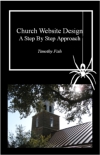
And Thy House
Extra Feature: High Res Image

History of
Cane Creek
Association
by D. F. Magruder
Church Website Mistakes
Written By: Timothy Fish Published: 2/7/2007
Learn about Church Website Design. Read Church Website Design: A Step By Step Approach by Timothy Fish.
Website design is a very subjective thing. What one person likes, someone else might not like at all. For that matter, I have found that, after designing a website that I liked, I might look at it later and question my sanity at the time. Even if you follow all the guidelines that people have developed (Who can?) there will always be things that are quite right. There will always be a difference in opinion on how something should look or if an approach should have been used. Donít let it worry you. It is your website and you can do with it what you want. With that being said, there are several things that I would consider to be a mistake if they are included or not include, as the case may be, in a church website.
1. Self Playing Audio/Video Files
My number one pet peeve with church websites and the first mistake in church website design is having a file that plays automatically when a user visits the site. There are some pages where this is fine and low background music in a loop is not too bad, but some church websites have music blaring the moment a user enters the site. Sometimes it is a low quality audio file, it could be a midi file or it could be Sister Snodgrass singing the Sunday special. What ever it is, most users donít want to hear it.
Another type of file that people use is a video file or even a digital talking head like those from SitePal.com. The video starts shortly after the website loads and the user is startled by the sudden break in the silence. He is left scrambling to find a way to turn it off. This might mean that he clicks the back button or closes the browser and never visits your site again.
If you want to make audio or video available to users, do so in a way that it is one their terms. Rather than automatically playing the file, provide a link to the file. Make it clear to them that it is an audio file. If they want to hear what you have to say through an audio file or through video (some will) then they will click on the link and will listen. If they donít then they will still be able to look for the information they need from your site.
2. Advertisements
One of the ways that some websites are able to generate revenue is through the sale of ads. Often it is through an affiliate program. Another company sells the ads and generates the content of the ads, but affiliate websites display these ads in exchange for getting a percentage of the proceeds from the clicks on the ads or from the sales that take place after a person clicks on one of the ads. This can be an attractive option that can help a website own pay for maintaining the site, but I would classify this as another mistake in church website design if it is used by a church.
Advertisements are ugly and detract from the information that is provided on the website, but the biggest problem with advertisements is that the webmaster had little control over which ads are displayed. Imagine a visitor coming to your site and looking around. The visitor may be interested in your church, but then sees and ad for another church. She clicks on that ad and never returns. If it is a church that your church would endorse then it might not be so bad, but what if it isnít? You really have no control over that and yet your site is being used to send people to another church.
Some people have the idea that the site will pay for itself if they use advertising. This may be true with some sites, but church websites are a little different. Church websites tend to have less traffic than business sites. Larger churches tend to have more traffic, but still it is somewhat limited. It turns out that most churches that have enough traffic to make selling ads worth while donít need the revenue from the ads and the churches that might need the revenue donít have enough traffic to make money from the program. Having the ads encourages webmasters to generate content that drives people to the ads rather than content that is good for the church website. If you must find a way to fund a church website, look for some other means.
3. Excessive Links to Other Sites
Some church websites are nothing but a bunch of links. They have no relevant information of their own except for the schedule of services and some other things. Added to that are links to sites were people can read the Bible online, find Bible reading schedules and learn about various organizations. There is nothing wrong with having a few links to some good sites, but there must be a limit. External links can be very unattractive, they give the appearance that the site has no information of its own and they are hard to keep up to date.
When churches have a lot of external links on the site, it is usually believed that the links will be useful to the website users. Often it is thought that the users are the members of the church and they will visit the website for this information. This usually doesnít happen. Users of websites are generally drawn to the website because of the information it contains rather than already existing and being interested in whatever the website might say.
External links can also draw people away from the site. A little of this is a good thing, because people might go through the church website to find other information, but if there are too many links then any other information the church website has will get lost in the mix. As a rule of thumb, it more than 5% - 10% of what is on the website is external links then the site has too many external links. These links should either be removed or hidden deeper in the site.
4. Splash Screen or Entry Page
Another mistake that can be made with a church website is to provide a splash screen or an entry page. A user might visit the site and all he sees is an images. There might be some texts that says, ďclick image to enterĒ or something like that, but there might not be. When a user who has never visited the site finds this, he is left wondering what he has to do to get in.
Generally, the people who have typed the URL into the browser are the only people who will see the entry page. Everyone else will have found a link to a specific page. This means that the people who will see the entry page are the people who are the least likely to know whether there is anything else on the site. Upon seeing the entry page, the user may conclude that the site is just a picture and he will go away. It is better to provide a page that directs users to other areas of the site as the primary page.
5. Out of Date Information
When a user visits a site that has information about events that have already occurred or when the most recent dates are several weeks old, the user has a clear indication that the website is not being kept up to date. If the user is looking for information about a church service that is occurring sometime during the current week then he will question any information he finds. He may conclude that it is not worth the risk. Out of date information gives the same appearance as having the windows of the church building boarded up. It appears that something was happening at one time, but now things are different.
The best way to deal with out of date information is to use a content management system like the one presented in Church Website Design, but just making a habit of going through the website at least once a week can greatly reduce the problem of out of date information.
6. Changing URLs for Archived Content
Once information has been displayed on the website, it should stay there. That might sound contrary to what was said about out of date information, but there are ways to archive data to inform the user that it is now out of date and still leave it in place.
Some webmasters make a mistake of moving articles to a different location on the server. A page might be in the News directory, but once it is out of date it might get moved to the Archives directory. This might make it easy for the webmaster to track, but it kills any links that someone else might have to this information. If we donít have links then our traffic suffers.
Instead of moving the file, use a system that changes the text in the document to indicate that the file is now archived. If this is done, the people who find the page from an external source will not find a dead link, they get the information they need and they are made away that the information is not as fresh.
7. Asking for Donations
You donít ask guest on Sunday morning to give an offering (at least I hope you donít), so why would you ask visitors to a church website to donate? There are some websites where people expect to be asked for money. Red Cross, etc. might ask for money and people might even visit the site to give money, but people donít normally visit a church website for that purpose.
Some church members might want to make a donation online. If this is what is intended by a donation form then it should be made clear that the form is for church members only. Others can use it if they please, but they should never be left with the impression that the church just wants money. Now if the church really does just want money then you are free to do as you like.
8. Excessive Use of Angels, Doves, Crosses, Etc.
Have you ever seen an angel? Me neither, but I have seen church websites that are covered with them. The excessive use of religious images can make a website look bad and it tends to exclude anyone who isnít quite as interested in seeing pictures of angels. Sites that use these things give the appearance of being created by religious extremist rather than people who can answer the visitorís questions with an open mind and an open heart.
Having one or two of these things in moderation is ok, but avoid cluttering the site with them. Remember that the important thing is the message that you are trying to communicate rather than how many angels will fit on the site.
9. No Contact Information
At some point, visitors to a site are going to need more information. There is always something that gets left out of the site. The visitor may just want to know how to find that information in the site. Every church website needs to have a way for people to contact the church. This information needs to be easy to find and there should be more than one method of contact. E-mail is one way, but a mail address and a phone number should also be included.
10. Too Much Emphasis on the Building
There is clearly some debate about the church buildingís role in the church website. Some people make a good argument that it shouldnít be shown because the people are what is important rather than the building. Others think it is good to show it. I have done a website without it and then I created an example website that has it. I like the result in the example website.
Whether you include it or donít include it is not near as important as how much emphasis you place on the building. If the visitor comes to the site and all he sees is the building then it is not good. If you are going to show it then put it in a place that it seems like it is more in the background and the users can look at it or not as they desire. The main focus of the site needs to be the message of the site and not the building.
11. Legalistic Doctrinal Statement
Anyone who has ever read a doctrinal statement knows that they are worded like a legal document. Churches have split over issues that have taken up no more space than one or two words in the doctrinal statement. The is means that anyone who is reading a doctrinal statement has to make a guess as to what the church really believes.
The doctrinal statement should be included on the website, but a more readable statement of what the church believes should be included as well. Some of what is included in the doctrinal statement is assumed. Other things are not clear. People generally assume that a church believes in God. What might not be as clear is the churchís view of baptism. Instead of going into detail about God, it might be better, for the benefit of site visitors, to focus on the things that make the church different from other churches. That is the information that visitors to the site really want.
12. Indistinctive Link Colors
Hypertext makes it possible to link specific words of a document to other documents. Usually, the hyperlinked text is displayed in a different color than most of the text and it is underlined, but it is possible to remove the underline and display it in the same color as the primary text. This is one way of making the document appear a certain way, but the user is left with no visual cue to indicate that a word is a link.
It is best to use colors for hyperlinks that are distinctively different from the main text of the document. This isnít a game of hide and seek. The user wants to know where the hyperlinks are and a webmaster should not hid them from him.
13. Poor Structure
The structure or organization of the website makes the difference between a user being able to navigate the site and find what he wants and a user who is left wondering how to find the information or if it exists at all. The structure is how the site is laid out. Generally, you can think of a website as being laid out in a type of tree. The home page is the root of the tree. Links on the home page may point to various layers of the tree, but the primary navigation system should be designed in such a way that everything of the same nature should have a similar link. If, for example, there is a button that links to the youth ministry then there should be a similar button that links to the senior adult ministry and one to the music ministry.
A visitor to the site should never be put in a situation where he guesses that he can find something by doing something that he did with something else and then he discovers that they are not treated the same way. Another thing that should be avoided is burying something so deep in the structure that no one ever finds it. A user should not have to click more than three or four times to find anything. On average a user should not have to click more than a couple of times to find what he needs.
14. Incorrect Use of Title and Description
The title and description are two of the most important pieces of a web document. When a user is searching for information in a search engine, it is often the title and description that make the difference between a user clicking on the link or moving to another. One mistake that is commonly made is using the same title and description for several pages. This can happen when pages are copied to make new pages or when the title and description are not linked to the database in content management systems.
The title is nearly always shown in the search results. Using a very boring title, like ďChurch Page TitleĒ or something else is a sure way to convince a few people to not bother. The title is the first thing and sometimes the only thing that people see of the website. It is worth spending some time developing titles.
The description may also be shown in the search results. Some search engines will always display the description. Other will only display it if the key words are in the description, but you can be sure that when you have optimized for certain key words, the user will be seeing the description if he used those words. So leaving out the description is clearly a church website mistake.
15. No Room for New Information
Websites donít usually run out of room on the server, but creating a church website that does not allow new information to be added easily is a church website mistake. A website needs to have a place for new information and a means to make it available quickly. In many cases, people have websites where the process for adding a new page requires a new page to be created and then one or more other pages to be modified to link to the page. This is a poor example of how to add new information. If adding new information is too difficult it will not be done.
As was mentioned before a content management system is needed to make it possible to add new information. If the site is designed properly, the webmaster need only enter the article into a form and the website will be updated. The article will be displayed on the correct pages and old information will disappear when it is out of date.
16. Bad Links
Bad links can kill a church website. A user visits, clicks on something and gets an error message. He clicks on something else and gets another error message. Bad links need to be avoided.
It isnít always possible to check for bad links by hand. There are tools available on the web that will check for bad links. Some are free and other are not. Find one that works for you and use it occasionally. Just remember that the more external links you have the more likely it is that you will lose a few.
17. Breaking the Back Button
Never, never, never try to keep a user on your website by preventing him from leaving. On method that some people try to do this is by preventing the user from using the back button. The user click back and the page just reloads with the same page. The user is forced to find another means to go back. Some webmasters may thing this is cute or inspired. It is not. It is just irritating.
The back button is key in the way that most of us browse the web. We click a link and hope it will tell us something, but we often have every intent to go back after we see what the other page has to show us. If the back button is broken we canít go back and we know who to blame, it is the guy who created the website we are currently looking at.
18. Low Contrast and Clashing Colors
I donít know what it is with church websites, but it seems like many of the people who develop them donít have a clue as to how to select colors that are attractive and readable. Look for colors that work well together and that have enough contrast to be readable.
One way to select colors is through a color chooser. There is also a section on the subject in Church Website Design.
19. News Services and Blindly Copied Information
When looking for content to use for updating the website, it can be attractive to use news feeds and other data that can be blindly copied without the webmaster having any input. There are several that are available, but the problem with this is that everyone else is using these too. Why would someone visit your church website just to see the same information that they have already seen in another location. Some web spiders may be the same way. Why should they visit your side just to get another copy something they have already gotten in several other places.
If you decide to use information that is available on other sites, donít use it as a blind feed. Read the articles first. If there is something your target audience might be interested in then put it on your website, but it there isnít then donít list is on your site. If only part of the article is important then write a summary and post it to the website.
20. Useless Games and Other "Sticky" Stuff
Sticky items are thing that can be included in a website in order to encourage people to return. There are two kinds. One kind is the things that are related to the site. The other kind is just things that are unrelated. The color chooser is an example of a sticky item that is related to the site. It is located on a site that is devoted to a book on website design, and the color chooser is even described in the book.
It is somewhat different for church websites. Often the sticky items that are available for them are of the second kind. The site should be about the church, but to get people to come back, the webmaster sticks in things like games and other things that are not even of a biblical nature. If a webmaster is going to use sticky stuff then if should be stuff that is related to the site and the church. If it is not then people will visit the site only for the games and they will ignore the rest.
Learn about Church Website Design. Read Church Website Design: A Step By Step Approach by Timothy Fish.
www.timothyfish.com



